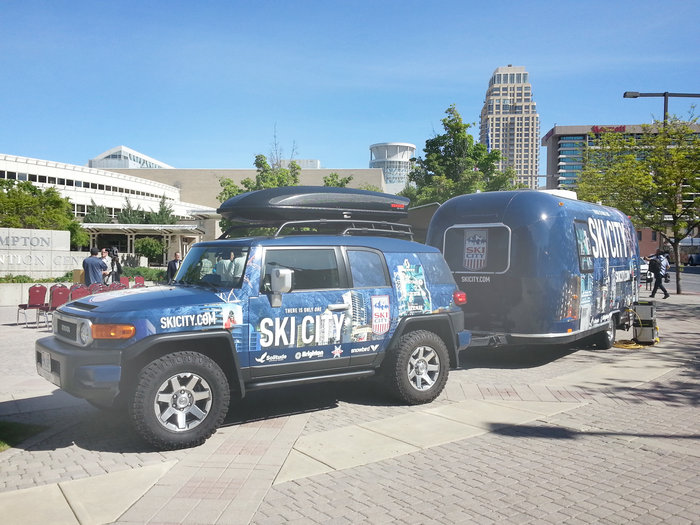They come. They spend. They leave. And they do it a lot.
They are Utah travelers and tourists, and their economic impact was celebrated last week during a special event at the Salt Palace Convention Center.
They come. They spend. They leave. And they do it a lot.
They are Utah travelers and tourists, and their economic impact was celebrated last week during a special event at the Salt Palace Convention Center.
The economic punch provided by travelers and visitors totals nearly $8 billion annually, supporting nearly 150,000 jobs in the state and boosting state and local tax revenues by $1.09 billion each year.
“Tourists come here, they stay in our hotels and eat in our restaurants, they shop in our stores, they visit the Salt Palace Convention Center, and they ski on our magnificent slopes, they visit our beautiful state and local parks, and then they go home,” Scott George, chairman of Visit Salt Lake’s board of trustees, said at a news conference marking Travel Rally Day, part of the 33rd annual National Travel and Tourism Week and highlighting travel and tourism’s impact on local, regional and state economies.
And, he added jokingly, “we don’t have to educate them and we rarely incarcerate them.”
Representatives from Visit Salt Lake, Salt Lake County, the Utah Office of Tourism and Ski Utah attended the event, and several speakers lauded the groups' collaboration and cooperation in making Utah’s a “remarkably strong tourism economy,” in the words of Erin Litvack, Salt Lake County community services director.
Litvack said the organizations’ goal is simple: “Get a lot of people to come to our community, experience everything we have to offer, spend a lot of money, and go home while having a little impact on our infrastructure.”
The impact of travel and tourism to the state’s economy is unquestioned, speakers said. The statistics indicate that:
• Visitors and travelers spent $7.98 billion in Utah in 2014, up 4.8 percent from the previous year.
• Travel and tourism supports one of every 10 jobs in Utah.
• The skiing, snowboarding and summer offerings at ski resorts amount to a $1.3 billion winter sports industry, including supporting 20,000 jobs. Visitors coming for the snow spend, on average, $315 per person per day.
• The state’s meetings and convention industry had record attendance in 2015, including booking 650,000 hotel room nights. The year also saw attendance records at the Salt Palace, topping the prior mark set in the Olympics year of 2002.
Nationally, travel accounts for 15 million jobs, or one in nine. Travel is a $2.1 trillion industry, with $927.9 billion in direct travel-related spending by visitors in 2014. It boosted federal, state and local tax coffers by $141.5 billion in 2014.
Speakers last week said the economic impact also is broad. The industry supports employees at airlines, hotels, restaurants, visitor attractions and retail sites, and boosts the construction, manufacturing and finance industries as well. David Williams, associate managing director at the Utah Office of Tourism, said the industry “not only stimulates the economy here in our capital city in Salt Lake, but also in our smaller towns and rural areas.”
Numbers aside, they added, traveling has positive effects on health and well-being for Utah residents and visitors. Children who travel with families are more likely to attend college and earn more as adults, George said. He described the industry as “a job creator, educator, pro-family and pro-health.”
“The economic boost is important, but a thriving tourism industry also gives us a chance to showcase the great quality of life that our residents and our workers enjoy,” Litvack said. “Tourism also allows us to be a part of the global marketplace as we tell our story to international visitors and news media, which then translates into additional visitors and spending.”
Williams said Utah enjoys a “halo effect” from tourism.
“Studies have shown that out-of-state individuals who have seen the state’s tourism marketing rate the state as a more-desirable place to live, a better place to start a career, a better place to raise a family,” Williams said. “One study showed that in Utah specifically for the tech industry, tech professionals are more likely to consider a job from a Utah company if they have previously visited the state.”
Utah tourism has come a long way during the past decade, he said, noting that in a 2005 image study, many people knew nothing about Utah. Now, Fodor’s has rated Utah as the top destination in the world to visit in 2016.
“The industry is generating a large economic impact for our citizens, and the future of travel and tourism is bright here in Utah,” Williams said.
Nathan Rafferty, president of Ski Utah, said another indication of the industry’s positive outlook is in the fact that Utah ski resorts spent more than $100 million on expansion and improvement projects last year. “They would not be doing that if they didn’t think there was a very bright future in this state,” he said.
As for the next few years, Beck said a lot rides on an August meeting of the American Society of Association Executives (ASAE), which will gather for its 2016 Annual Meeting & Exposition in Salt Lake City. He described the group as “the association for associations.”
“We consider this the Super Bowl of all conventions in terms of what it could mean for the future business development opportunities that we have as a destination,” he said, adding that the long-term benefits of hosting ASAE could amount to more than $500 million in long-term economic impact. “We’re ready to show off Salt Lake’s best assets.”








